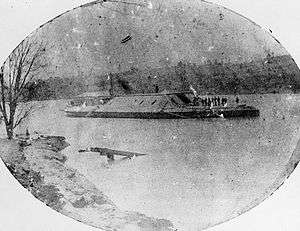CSS Muscogee
CSS Muscogee was an ironclad ram built for the Confederate States Navy during the American Civil War. She was known as Muscogee while being built and up until her launching; after that all surviving Confederate records refer to her as the "ironclad ram Jackson." No official explanation survives as to why her name was changed.
 The incomplete CSS Muscogee shortly after her launching on the Chattahoochee River | |
| History | |
|---|---|
| Name: | Jackson |
| Launched: | December 22, 1864 |
| General characteristics | |
| Type: | Ironclad Ram |
| Displacement: | 2000 tons |
| Length: | 223.5 ft (68.1 m) |
| Beam: | 56.5 ft (17.2 m) |
| Draft: | 8 ft (2.4 m) |
| Propulsion: | Steam engine |
| Armament: | Four 7-inch Brooke Rifles; two 6.4-inch Brooke Rifles; two 12 pounder boat howitzers. |
| Armor: | 4 inches of plate iron over 20 inches of White Oak |
CSS Muscogee and Chattahoochee | |
| NRHP reference No. | 70000212[1] |
| Added to NRHP | May 13, 1970 |
History
The ironclad was built during 1862 at Columbus on the banks of the Chattahoochee River, Georgia and was finally commissioned as CSS Jackson in December 1864.[2] The Columbus Naval Iron Works supplied all the machinery installed aboard Jackson. The ship faced multiple setbacks and delays that ultimately prevented her from entering C.S. Naval service and engaging elements of the larger Union blockade of the Confederacy.[3]
On 16 April 1865, while still needing fitting out, Jackson was set ablaze, then scuttled by the Union's Wilson's Raiders during the Battle of Columbus, Georgia. This engagement is sometimes regarded as the "Last Battle of the Civil War."[4][5] (On April 20, Wilson's men captured Macon, Georgia without resistance, and Wilson's Raid came to an end. This was only six days prior to General Joseph E. Johnston's surrender of all Confederate troops in the Carolinas, Georgia, and Florida to William Tecumseh Sherman in North Carolina.)
CSS Jackson's remains were raised a century later, during the early 1960s, from that portion of the river inside the boundaries of Fort Benning; her surviving below-the-waterline hull was then placed on exhibit at the National Civil War Naval Museum in Columbus. A thick metal white frame outline, indicating the various dimensions of Jackson's original fore and aft deck arrangements and armored casemate, is now erected directly above the hull's wooden remains to simulate for visitors the ironclad's original size and shapes.
See also
- Bibliography of American Civil War naval history
References
Citations
- "NPS Focus". National Register of Historic Places. National Park Service. Retrieved January 2, 2012.
- Sullivan, 2010, p.93
- Inscoe, 2011, p.61
- "Civil War Times, April 2003". Archived from the original on 2017-08-02. Retrieved 2013-11-14.
- ""The Last Battle of The Civil War," by Charles Swift". Archived from the original on 2017-08-02. Retrieved 2013-11-14.
Bibliography
- Bisbee, Saxon T. (2018). Engines of Rebellion: Confederate Ironclads and Steam Engineering in the American Civil War. Tuscaloosa, Alabama: University of Alabama Press. ISBN 978-0-81731-986-1.
- Holcombe, Robert (1988). "Question 17/86". Warship International. XXV (2): 213–214. ISSN 0043-0374.
- Inscoe, John C. (2011). The Civil War in Georgia: A New Georgia Encyclopedia Companion. University of Georgia Press. p. 305. ISBN 9780820341385., Book
- Silverstone, Paul H. (2006). Civil War Navies 1855–1883. The U.S. Navy Warship Series. New York: Routledge. ISBN 0-415-97870-X.
- Still, William N. Jr. (1985). Iron Afloat: The Story of the Confederate Armorclads (Reprint of the 1971 ed.). Columbia, South Carolina: University of South Carolina Press. ISBN 0-87249-454-3.
- Sullivan, Buddy (2010). Georgia: A State History. Arcadia Publishing. p. 208. ISBN 9780738585895., Book
External links
- United States Naval Historical Center - CSS Muscogee (1864-1865) - retrieved July 27, 2006
- Cultural Resources Management at Fort Benning - retrieved July 1, 2008
- Confederate Ironclads - retrieved July 27, 2006
- HNSA Web Page: CSS Jackson (alternate name for CSS Muscogee)